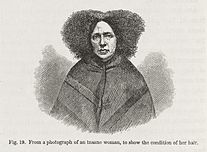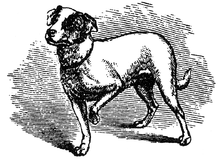“평화와 인류 발전 위해 새로운 패러다임 필요” : 신동아==
2014-05-22
“평화와 인류 발전 위해 새로운 패러다임 필요”
몬테비데오 ILC 국제지도자회의 참관기우루과이 몬테비데오 = 구자홍 기자 | jhkoo@donga.com
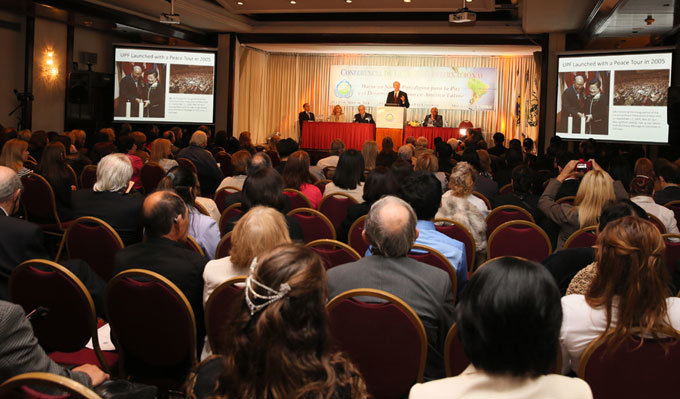
우루과이 몬테비데오에서 4월 21일부터 23일까지 UPF 주최 ILC 국제지도자회의가 열렸다.
우루과이는 우리나라와 지구 정반대편에 위치해 비행기로 하루 24시간을 꼬박 날아가야 닿을 수 있는 나라다. 너무 먼 탓에 한국에서 한 번에 날아가는 비행기가 아직 없다. 12시간을 날아간 뒤에 잠시 기착해 연료를 주입하고 다시 12시간 넘게 날아가야 도달할 수 있다. 지구 대척점에 있는 먼 나라지만 우루과이는 우리에게 비교적 친숙하다. 20여 년 전 쌀 시장 개방 문제를 둘러싸고 국내에서 극심한 논란을 불러일으켰던 ‘우루과이라운드 협상’ 개최국이기 때문이다.
우루과이 수도 몬테비데오는 아르헨티나 수도 부에노스아이레스와 라플라타 강을 사이에 두고 위치해 있는데, 강폭이 세계에서 가장 넓어 시속 100km로 달리 는 쾌속선으로도 2시간 30분이 족히 걸린다. 평화롭게 보이지만 라플라타 강은 제2차 세계대전 당시 영국 순양함대와 독일 포켓전함 사이에 격렬한 해전이 치러진 전장의 역사를 갖고 있다.
완충국 우루과이
우루과이 국토 면적은 17만6000㎢로 한반도 면적의 5분의 4에 해당한다. 그러나 인구는 334만 명(2012년 기준)에 불과하다. 그 가운데 134만 명이 수도 몬테비데오에 모여 산다. 좁은 땅에 많은 인구가 모여 사는 한국에 비해 넓은 땅에 적은 인구가 사는 우루과이는 모든 것이 여유로워 보였다. 도로를 달리는 자동차도 많지 않았고, 해변도 한산했다. 폭이 2~3㎞ 돼 보이는 드넓은 백사장을 고작 십수 명의 사람이 점유한 풍경이 이채로웠다. 도심도 한눈에 주요 건물을 조망할 수 있을 만큼 오밀조밀하다. 시내 한복판에 자리 잡은 독립광장을 중심으로 살보 왕궁과 대통령 집무실이 자리잡고 있다. 독립광장 남측에는 우루과이에서 가장 큰 특급호텔 래디슨 몬테비데오 빅토리아 플라자 호텔이 서 있다.
우루과이는 우리나라와 유사한 점이 많다. 북반구와 남반구 차이로 계절이 정반대인 점을 제외하면 기후도 비슷하거니와 브라질과 아르헨티나 등 강대국에 둘러싸인 지정학적 위치가 꼭 닮았다. 아르헨티나와 브라질의 침략을 딛고 현재의 완충국 지위를 유지하는 모습은 중국과 일본 사이에서 균형자 노릇을 하는 대한민국 상황과 흡사하다.
몬테비데오 시내 중심에 자리 잡은 독립광장에는 독립영웅 ‘호세 헤르바시오 아르티가스’ 동상이 서 있다. 스페인 군인 출신인 아르티가스는 몬테비데오를 점령한 아르헨티나군을 격파한 뒤, 1816년 우루과이 행정구역을 6개 주로 분할하고 몬테비데오에 최초의 학교와 도서관을 건립한 영웅이다.
4월 21일부터 23일까지 천주평화연합(UPF·Universal Peace Federation) 주최로 국제지도자회의(ILC·Inter-national Leadership Conference)가 래디슨 몬테비데오 빅토리아 플라자 호텔에서 열렸다. ‘평화와 인류 발전을 위한 새로운 패러다임을 지향하는 라틴아메리카’를 주제로 열린 ILC에는 전직 국가원수와 국회의원 등 우루과이를 대표하는 지도자들과 함께 남미 각계 지도자가 참석, 항구적 평화세계 건설을 위한 구체적 방안을 놓고 열띤 강연을 이어갔다.
세계평화통일가정연합 측은 “문선명 총재(2012년 작고)와 함께 천주평화연합을 공동 창설한 한학자 총재가 평화통일 세계 실현이라는 중대한 과업을 이어가기 위해 국제지도자회의 개최지를 몬테비데오로 선택했다”고 밝혔다.

몬테비데오 독립광장. 우루과이 독립영웅 ‘아르티가스’ 동상 뒤로 대통령 집무실이 보인다(왼쪽). 우루과이와 아르헨티나 사이에 흐르는 라플라타강.
=
=만찬을 겸해 열린 4월 21일 개회식에는 전 우루과이 대통령 영부인 메르세데스 여사가 환영사를 했다. 메르세데스 여사는 여러 사람과 평화를 나누는 데‘예술’이 좋은 방법이 될 수 있음을 역설했다. 그는 “각자의 마음속에 평화가 숨 쉬고 있다고 굳게 믿는다”며 “각자의 삶 속에서 평화를 실현하기 위해 활동하는 분들이 이웃에게 평화의 씨를 뿌리는 평화대사가 되기를 기원한다”고 밝혔다.
4월 22일 열린 ILC 본회의에는 한 총재를 대신해 문선진 세계평화통일가정연합 세계본부 본부장이 참석, 한 총재의 기조연설문을 대독했다. 연설문에서 한 총재는 ▲자연환경을 보호하면서 식량문제에 앞장서자 ▲국경과 인종, 종교의 벽을 헐고 ‘하나님 아래 인류 한 가족’의 이상을 실현하자 ▲남북미 종교화합과 일치에 앞장서자 ▲국경이 없는 자유와 평화, 통일과 행복의 신세계를 실현하는 액션플랜을 만들자고 제안했다.
이날 회의에는 ‘평화의 글로벌 비전’을 주제로 두 명의 전직 우루과이 대통령이 기조연설을 했다. 오전에 연단에 오른 루이스 알베르토 라칼레 전 우루과이 대통령은 “서로 다른 문화권에서 저마다 평화를 추구한다는 것을 수용하고, 영적 가치로 물질적 욕망을 제어해나가야 한다”고 강조했다. 라칼레 전 대통령은 재임(1991~1995) 중 남미공동시장(메르코수르)을 출범한 주인공이다. 현재 메르코수르 사무국은 몬테비데오에 있다. 라칼레 전 대통령은 “(메르코수르는) 상업적인 연합으로 무역을 촉진하는 것을 목표로 삼았다”며 “우루과이 주변 국가에 3억 명이 거주해 무역을 촉진하는 것이 중요했다”고 회고했다. 다음은 기조연설 뒤 가진 일문일답 요약.
▼ 우루과이는 브라질, 아르헨티나에 비해 작은 나라다. 우루과이 외교정책의 중점은 무엇인가.
“주변 국가들은 우루과이가 생기는 것을 원치 않았다. 그 때문에 작은 나라인 우루과이는 주변국과의 관계를 예의 주시하고 국제정책에 늘 신경을 써야 한다. 내가 대통령 재임 때 남미에 메르코수르를 창설했다. 주변국과 상업적인 연합으로 무역을 촉진하는 것을 목표로 삼았다. 주변 국가에 3억의 인구가 거주하므로 (무역을 촉진하는 것은) 중요한 문제다. 그런데 지난해 우루과이 좌익정부세력과 베네수엘라, 아르헨티나가 정치클럽을 만들어 이것(메르코수르)을 바꿨는데, 잘 안 된다. 잘될 수가 없는 시도다.”
▼ 국민의 행복을 위해 정부가 해야 할 가장 중요한 역할이 무엇이라고 생각하나.
“우루과이는 매우 훌륭한 대중 무상교육 시스템을 가졌다. 그 덕에 대중교육을 상위 수준으로 끌어올릴 수 있었다. 자본은 사람들의 두뇌에서 나온다.”
한편 ILC를 주관한 UPF 세계회장 토마스 왈쉬 박사는 “가정이 세계평화의 초석이며 사랑의 학교”라며 “문화와 인종, 종교의 벽을 초월하는 것이 조화와 평화세계 실현의 유일한 길”이라며 “다른 그룹 간 대화의 중요성”을 강조했다.
“평화 지키려는 노력은 전쟁을 막는 백신”
| 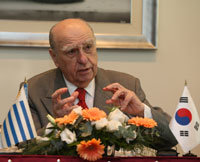 훌리오 마리아 상귀네티 전 우루과이 대통령.
- 전쟁의 역사를 가진 한국은 평화에 대한 각별한 의미를 잘 안다. 우루과이에도 평화를 강조할 만한 역사가 있나.
“남미 여러 나라의 독립운동사와 우루과이의 전쟁사는 곧 평화를 향한 여정과도 같다.”
상귀네티 전 대통령은 남미와 우루과이 독립운동사를 정확한 연도를 제시하면서 자세히 설명했다. 그의 뛰어난 기억력이 놀라웠다.
“1904년 내란이 우루과이의 마지막 전쟁이었다. 그 이후 우루과이에는 전쟁이 없었다. 다만 이것은 전통적인 전쟁에 대한 이야기다. 남미에는 (전통적인 전쟁 외에도) 게릴라 분쟁이 있다. 우루과이에는 1963년부터 1973년 사이에 마오이스트 게릴라 활동이 있었다. 그러다 1973년에 우익 군사쿠데타가 발생해 1985년까지 군부가 정권을 장악했다. (1985년 대통령에 취임한) 내가 우루과이 첫 번째 민간 정부 대통령이다. 오전에 연설한 라칼레 전 대통령이 두 번째 민정 대통령이고, 이후 내가 대통령에 재선됐다. 우루과이 헌법은 두 번 연속으로 대통령직을 맡지 못하게 규정돼 있다.”
- 우루과이가 국제관계에 임하는 원칙은 무엇인가..
“우루과이는 국제법을 준수하는 평화로운 나라다. 작은 나라는 국제법을 따르는 것이 국가안보와 연결된다. 우루과이에 대한 외국의 위협은 없다. 브라질, 파라과이, 아르헨티나, 칠레와의 분쟁 가능성은 없다. 과거 라틴아메리카에 서 벌어졌던 분쟁이 하나씩 마무리돼간다. 예를 들어 칠레와 페루의 해양경계선 분쟁은 19세기 전쟁의 결과로 생긴 것이다. 그러나 양국이 국제사법재판소(ICJ) 판결을 받아들이려 한다. 이것은 남미에 굉장히 중요한 발전이라고 할 수 있다. 우루과이도 갈등을 평화롭게 해결해나간다.”
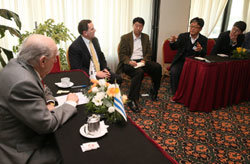 상귀네티 전 대통령과의 인터뷰는 한국어, 영어, 스페인어 3원 동시통역으로 진행됐다.
“메르코수르는 평화의 결과라고 생각한다. 그리고 경제적 기반이 평화를 유지하는 데 도움이 된다. 메르코수르는 우리가 공존하기에 생긴 것이다. 경제적으로 좋아졌지만 과거 수년간은 상업적인 차이 탓에 경제적 통합 성과를 크게 이뤄내지 못했다.”
- 세계 평화를 유지하는 데 한국과 우루과이의 처지가 비슷한 것 같다. 양국이 앞으로 어떤 부분에서 협조할 수 있다고 보나..
“먼저 국제기구를 통해 협조하는 것이다. 평화를 위해 국가가 (국제기구 등에서) 싸우는 것은 중요한 일이다. 둘째로는 평화의 중요성을 다른 나라에 확산시켜나가는 것이다. 갈등을 조장하고 평화에 위협이 되는 행위를 지지하거나 용인하지 말아야 한다.”
|
|
==
“평화와 인류 발전 위해 새로운 패러다임 필요”
몬테비데오 ILC 국제지도자회의 참관기
우루과이 몬테비데오 = 구자홍 기자 | jhkoo@donga.com
입력2014-05-22
세계평화의 중요성
인류 역사를 보면 평화보다 전쟁의 시기가 많다. 현 시점도 예외는 아니다. 제2차 세계대전 이후 70년 가까이 비록 세계적으로 여러 국가가 동시에 참여한 대규모 전쟁은 없었지만 30년 이상 지속된 미소 냉전을 비롯해 지구촌 곳곳에서 국지전은 끊임없이 발생했다. 이스라엘과 팔레스타인의 분쟁, 베트남전, 그리고 걸프전과 이라크전….
우리가 발 디디고 선 한반도 상황도 예외는 아니다. 표면상 평화가 깃든 것처럼 보이지만 내면을 들여다보면 한반도는 6·25전쟁 이후 현재까지 ‘정전’ 상태다. 우리가 전쟁 이후 지금껏 고도성장을 이룩하며 선진국 문턱에 이를 수 있었던 것은 외교적 노력 등을 통해 한반도에서 제2의 6·25전쟁이 발발하지 않도록 효과적으로 제어해왔기에 가능한 일이다.
우리가 평화를 위해 노력하는 것과 별개로 전쟁과 분쟁 요인은 상존한다. 당장 우리와 군사분계선을 맞댄 북한이 핵무기를 개발하는 상황은 우리 안보와 평화에 심각한 위협이 아닐 수 없다. 평화를 지키려는 노력을 게을리할 수 없는 이유다.
국가와 정부는 국민의 생명과 재산을 지켜야 할 책무가 있다. 국민이 낸 세금으로 국방을 튼튼히 하고 외교적 노력 등을 통해 한반도 평화 유지를 위해 힘을 쏟아야 한다. 그러나 평화는 정부와 대통령의 노력만으로는 한계가 있다. ‘적전분열=패망’의 공식은 역사적으로 흥망성쇠를 거듭한 다른 국가의 예에서 어렵지 않게 찾아볼 수 있다. 국론 분열 상황을 극복하고, 한반도를 뛰어넘어 국제사회로부터 한반도 평화에 대한 동의를 얻어낼 때 비로소 한반도는 전쟁과 분단 위기를 극복하고 평화를 쟁취할 수 있다.
우리나라와 지구 정반대편에 있는 몬테비데오에서 열린 국제지도자회의에서 참석자들은 ‘평화세계 실현을 위해 각국 지도자들이 위대한 도전에 나서자’는 데 뜻을 모았다. 12시간의 시차가 나고 계절은 반대지만, 우루과이에서 한목소리로 뜻을 모은 ‘평화세계’에 대한 염원은 어찌 보면 북한의 4차 핵실험이 예고된 한반도에 더욱 절실한 메시지가 아닐 수 없다.
무럭무럭 성장한 ‘상파울루 선언’…남미에 27억 평 ‘이상촌’ 건설 중
1965년 7월 9일. 문선명 세계평화통일가정연합 총재는 브라질 리우데자네이루의 시네란디아 광장에 한국에서 가져온 흙과 돌을 묻고 첫 성지를 택정했다. 이후 문 총재 부부는 수차례 중남미 각국을 순방하며 선교의 씨앗을 뿌렸다. 특히 문 총재는 1995년 3월 31일 브라질 상파울루에서 “자르딘에 ‘새소망농장’을 중심으로 3억 평, 파라과이에 2억 평, 우루과이와 아르헨티나에 1억 평 등 총 6억 평의 땅을 매입해 이상촌을 건설하겠다”는 이른바 ‘상파울루 선언’을 발표했다.
각국 청년들을 투입해 160개 국가별로 나눠 개발하겠다는 20여 년 전의 야심 찬 계획은 2014년 5월 현재 27억 평(약 89억㎡)에 달하는 거대한 땅으로 구현됐으며, 국경과 민족, 종교와 언어 등 모든 장벽을 초월한 이상공동체로 성장했다. 판타날은 세계에서 가장 큰 습지이자 유네스코 세계자연유산으로 등재됐으며, 80% 이상이 원래의 모습대로 보존되고 있다.
가정연합 관계자는 “올해는 문선명 총재께서 세계평화통일가정연합을 창설한 지 60주년이 되는 뜻 깊은 해”라며 “문 총재께서 ‘상파울루 선언’을 하고 남미에 이상촌 건설을 시작한 지 20년 만에 당초 계획보다 4배 이상 넓은 땅에 이상촌을 세우는 중”이라고 설명했다.
가정연합은 남미에서 새소망농장과 같은 대규모 농장 건설 외에도 언론사와 교육기관, 호텔 등 다양한 사업 분야에 진출해 활발히 활동한다. 우루과이는 물론 남미에서도 손꼽히는 특급호텔이자 몬테비데오 국제지도자회의가 개최된 래디슨 몬테비데오 빅토리아 플라자 호텔 역시 가정연합이 투자해 운영한다.
올해로 ‘창립 60주년’을 맞은 가정연합은 5월 1일, 한학자 총재 주도로 경기도 청평에 있는 천정궁박물관 채플실에서 기념식을 열고 40년 동안 장기 근속한 네 가정에 특별공로상을 수여했다.
5월 11일에는 청심평화월드센터에서 2만2000명이 참석한 가운데 ‘Vision 2020 승리를 위한 세계연합예배’를 진행했다.
이날 한 총재는 문선진 세계본부 본부장과 김만호 사무총장을 임명하고, 양창식 북미·남미, 오야마다 히데오 중화권·동북, 사광기 서유럽, 문난영 동유럽, 케시 리그니 아프리카, 로버트 키틀 아시아 교육담당, 용정식 아시아대륙회장 겸 총사 등 8명을 특명총사로 임명했다.
또한 기존 10개 대륙으로 나뉘었던 세계본부를 중미와 중화권을 신설하고 아프리카를 동서로 나눠 총 13개 대륙으로 확장했다. 김상석(중미), 장귀성(중화권), 조동호(서아프리카), 베커리 카마라(동아프리카) 등 4명이 신설대륙 회장으로 임명됐다. 이들과 함께 박종인 중동대륙 레바논 국가회장이 임명장을 받았다.
==







 혼도니아 주정부의 한국 농장 허가 공문1966년 5월 26일 ‘아마존 개척단’의 선발대가 구성되었다. 교민단체였던 한백문화협회를 통해 대원을 모집했다. 서독에 광부로 갔다가 본국으로 돌아가지 않고 브라질로 온 청년들도 신청했다. 오응서씨를 단장으로 하여 한국 청년 12명, 농사지도원 즈다 (일본 농대 출신, 농업기사), 법률지도원 Milleno (브라질 변호사, 상파울루주 고문 변호사), 행정지도원 Waldmil (전 혼도니아주 농림국장) 등으로 선발대가 구성되었다. 개발대상지역은 연방직할주 혼도니아주 수도 Porto Velho시에서 16킬로미터 지점에서부터 아그레주로 향하고 볼리비아의 관문인 Guajaramilim 근처까지의 마데이라 강변이었다.
혼도니아 주정부의 한국 농장 허가 공문1966년 5월 26일 ‘아마존 개척단’의 선발대가 구성되었다. 교민단체였던 한백문화협회를 통해 대원을 모집했다. 서독에 광부로 갔다가 본국으로 돌아가지 않고 브라질로 온 청년들도 신청했다. 오응서씨를 단장으로 하여 한국 청년 12명, 농사지도원 즈다 (일본 농대 출신, 농업기사), 법률지도원 Milleno (브라질 변호사, 상파울루주 고문 변호사), 행정지도원 Waldmil (전 혼도니아주 농림국장) 등으로 선발대가 구성되었다. 개발대상지역은 연방직할주 혼도니아주 수도 Porto Velho시에서 16킬로미터 지점에서부터 아그레주로 향하고 볼리비아의 관문인 Guajaramilim 근처까지의 마데이라 강변이었다.











